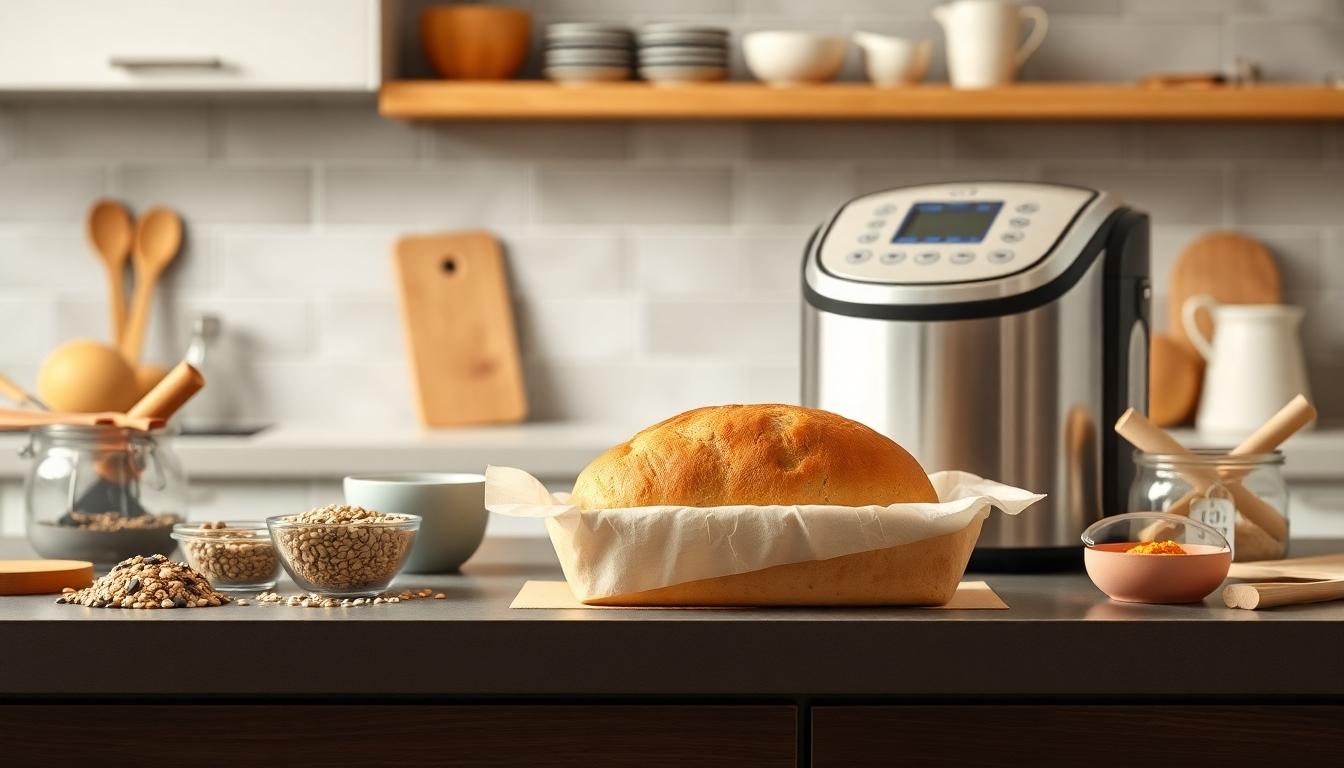Table of Contents
ToggleImagine walking into your kitchen and being greeted by the warm, inviting aroma of freshly baked bread. Now, picture that bread being not just delicious but also healthy. With a bread machine at your side, this dream can become a reality. Hearty whole grains, seeds, and even sneaky veggies can transform your loaf into a nutritional powerhouse without the fuss of traditional baking.
Healthy bread machine recipes don’t just save time; they also save your taste buds. No more cardboard-like loaves from the store. Instead, you’ll whip up soft, fluffy bread that even your pickiest eater won’t resist. Whether it’s a nutty multigrain or a zesty herb-infused delight, your bread machine is ready to work its magic. So roll up your sleeves and get ready to impress your family with bread that’s as good for them as it is for their taste buds.
Overview Of Healthy Bread Machine Recipes
Healthy bread machine recipes emphasize the use of nutritious ingredients. Whole grains, such as whole wheat and rye, serve as foundational elements. Many recipes include seeds, such as flaxseeds and sunflower seeds, for added texture and nutrients. Incorporating vegetables, like spinach or carrots, enriches dough with vitamins and minerals.
Different types of flour can enhance the bread’s health benefits. Oat flour and almond flour provide alternative options for those seeking gluten-free solutions. Sugars and fats can be minimized; using honey or applesauce makes a suitable substitution for refined sugars. Similarly, olive oil or avocado oil offers healthier fat choices.
Recipes vary in complexity, accommodating all skill levels. Basic whole wheat recipes work well for beginners, while advanced bakers may enjoy crafting sourdough or artisan-style loaves. Detailed instructions ensure that every recipe is easy to follow, ensuring consistent results.
Bakers can also experiment with add-ins that elevate flavor profiles. Nuts, such as walnuts or almonds, introduce crunch, while dried fruits like cranberries or raisins add sweetness. These variations allow for personalization, catering to different tastes and dietary preferences.
Nutrition becomes a focus when creating bread. Each recipe can be tailored to address specific dietary needs, like low-carb or increased fiber options. With careful selections of ingredients, homemade bread not only satisfies cravings but benefits overall well-being.
Overall, healthy bread machine recipes provide various avenues to explore nutritious and tasty loaves. They encourage creativity and experimentation, making the baking process both enjoyable and beneficial.
Benefits Of Using A Bread Machine

Using a bread machine offers numerous advantages, especially for those focused on healthy homemade bread. Simplifying the baking process significantly enhances convenience and encourages more frequent baking.
Convenience And Time-Saving
Efficiency defines the use of a bread machine. With the ability to mix, knead, rise, and bake, individuals save time compared to traditional methods. Most recipes include straightforward instructions, allowing easy preparation with minimal cleanup.
The programmable settings cater to different schedules, enabling bread to bake while one focuses on other tasks. Users can enjoy the aroma of fresh bread without constant monitoring or labor-intensive processes. Experimenting with various ingredients becomes hassle-free, empowering creativity in the kitchen.
Consistent Results
Consistency distinguishes bread machines from manual baking. Reliable temperature control and precise timing ensure uniform texture and flavor in each loaf.
With automated kneading and rising cycles, the likelihood of mishaps reduces significantly. Recipes consistently yield bread that rises properly, giving bakers confidence in their efforts. This dependability encourages experimentation with healthy ingredients like whole grains and seeds, fostering a rewarding baking experience. Adapting recipes for dietary needs becomes easy, leading to delicious outcomes every time.
Essential Ingredients For Healthy Breads
Healthy breads begin with quality ingredients, ensuring both nutrition and flavor in each loaf. Understanding what goes into the bread enhances cooking practices and results.
Whole Grains
Whole grains form the backbone of nutritious bread recipes. Whole wheat flour provides fiber, vitamins, and minerals, contributing to overall health. Rye flour adds a distinct flavor and extra texture, promoting heart health. Oat flour, gluten-free and rich in antioxidants, offers versatility for various dietary needs. By mixing different kinds, bakers craft unique tastes and textures. Selecting whole grains ensures higher nutritional value, making healthy breads appealing to everyone at the table.
Natural Sweeteners
Natural sweeteners serve as healthier alternatives to refined sugars in bread recipes. Honey enhances not only sweetness but also adds moisture, improving the bread’s texture. Maple syrup offers vitamins and minerals, enriching the flavor profile. Agave nectar, having a lower glycemic index, allows for a subtle sweetness without affecting blood sugar levels significantly. Using these natural ingredients can transform standard recipes into health-conscious delights, appealing to those seeking healthier loaf options.
Popular Healthy Bread Machine Recipes
Healthy bread machine recipes offer a variety of options for nutritious homemade loaves. Here are some popular choices.
Whole Wheat Bread
Whole wheat bread features the rich flavor and texture of whole wheat flour. This recipe typically uses a blend of whole wheat flour and vital wheat gluten, enhancing the bread’s elasticity. Adding honey or maple syrup provides a touch of natural sweetness. Users often include seeds like sunflower or flaxseeds for added nutrients and texture. The bread machine handles all steps, from mixing to baking, ensuring a consistently delicious loaf. Whole wheat bread serves as an excellent source of fiber, promoting digestive health while satisfying cravings for hearty flavors.
Oatmeal Bread
Oatmeal bread combines the goodness of oats with whole wheat flour for a wholesome loaf. The recipe usually includes rolled oats, which contribute a soft texture and nutty flavor. Users might add honey for sweetness or incorporate mix-ins like raisins or nuts for variety. This type of bread offers essential vitamins and minerals, making it a nutritious option for breakfast or snacks. The slow-release carbohydrates from oats provide sustained energy throughout the day. Bread machines simplify the process, producing a perfectly baked oatmeal bread that appeals to everyone.
Gluten-Free Bread
Gluten-free bread accommodates individuals with gluten sensitivities while still providing deliciousness. Common ingredients include almond flour, brown rice flour, and tapioca starch, which create a light and airy texture. Users often include xanthan gum to improve structure and elasticity. Flavor enhancers like chia seeds or dried herbs can elevate the taste. This recipe is popular among health-conscious bakers, offering a solution for gluten-free diets without sacrificing taste. The bread machine makes crafting gluten-free loaves easy, ensuring consistent results for every baking session.
Tips For Perfecting Your Bread Machine Experience
Achieving the best results from a bread machine involves some helpful tips. Following specific guidelines enhances the baking experience and ensures delicious loaves.
Choosing The Right Bread Machine
Selecting the appropriate bread machine impacts outcomes significantly. Look for models with versatile settings that accommodate various recipes, including gluten-free options. Consider machines with programmable features that allow for delayed baking times. A machine with a large capacity is ideal for families or meal prepping. Check for user-friendly controls and clear instructions that simplify the baking process. Additionally, choose a model with non-stick bread pans for easy cleanup, which contributes to a more enjoyable baking experience.
Adjusting Recipes For Altitude
Adapting recipes for high-altitude baking may improve texture and rise. At elevations above 3,000 feet, adjustments in flour and liquid ratios become essential. Reducing flour by 1 to 2 tablespoons can enhance dough consistency, while increasing liquid by 1 to 2 tablespoons can help retain moisture. Keep in mind that bread may require a shorter baking time, so monitoring the baking process remains crucial. Consider adding additional yeast to support proper rise, which compensates for the reduced atmospheric pressure. Finally, experimenting with these adjustments allows for successful baking at elevated heights.
Exploring healthy bread machine recipes opens up a world of nutritious and delicious possibilities. With the convenience of a bread machine, anyone can create wholesome loaves that cater to various dietary needs. From whole grain options to gluten-free alternatives, the versatility of these recipes makes it easy to experiment and find the perfect blend of flavors and textures.
By incorporating quality ingredients like whole grains, seeds, and natural sweeteners, bakers can enhance the nutritional profile of their bread while delighting their families with homemade goodness. Whether it’s a simple whole wheat loaf or a creative oatmeal bread, the joy of baking healthy bread at home is both rewarding and beneficial for overall well-being. Embrace the journey and enjoy the delicious results.





